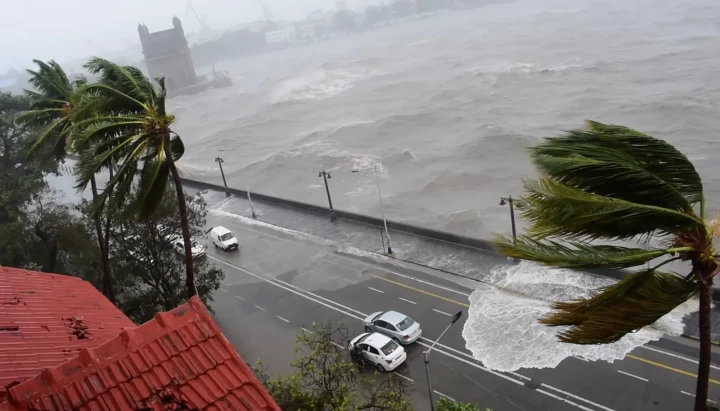
ইনসাইড ওয়েদার
Year’s 1st cyclone Asani likely to form over Bay of Bengal on 21 March
প্রকাশ: 17/03/2022

This year's first
cyclone—Asani—is likely to form over the central Bay of Bengal on 21 March. It
is unlikely to cross the Indian coast but heavy rain and strong winds are
expected over Andaman and Nicobar Islands, India Meteorological Department
(IMD) said.
A low-pressure area was formed over the equatorial Indian
Ocean and the southwest Bay of Bengal on Tuesday evening. It was over central
south Bay of Bengal on Wednesday. The low-pressure area is likely to move and
become a well-marked low-pressure area over the southeast Bay of Bengal and the
Andaman Sea around 19 March. Thereafter, it is likely to move
north-north-westwards along and off Andaman and Nicobar Islands and intensify
into a depression by the morning of March 20 and cyclonic storm Asani on 21
March, IMD said.
"For now, it does not seem like it will affect the
Indian coast. Our models indicate Asani may cross Bangladesh or adjoining north
Myanmar coasts. But it is also too early to say what will be the trajectory.
All conditions are favourable for formation and intensification of the
cyclone," said an IMD official.
On 19 March, light to moderate rainfall/thundershowers are
likely in the south Andaman Sea. Heavy to very heavy rainfall is expected at a
few places and extremely heavy rainfall at isolated places in Andaman and
Nicobar Islands.
Strong winds reaching 40-50 kmph gusting to 60 kmph are very
likely over the Bay of Bengal and the equatorial Indian Ocean till 18 March.
Wind speed is gradually expected to increase by March 21. Gale winds speed
reaching 70-80 kmph gusting to 90 kmph are very likely over Andaman and Nicobar
Islands and the Bay of Bengal. On 23 March, gale winds speed reaching 70-80
kmph gusting to 90 kmph are very likely over the Bay of Bengal and Bangladesh
and Myanmar coasts.
"If the forecast materialises, Tropical #CycloneAsani
will become the first ever tropical cyclone to hit Andaman and Nicobar Islands
in March. Not a single tropical cyclone has hit the region in March in at least
132 years," tweeted Akshay Deoras, a meteorologist at the University of
Reading, UK.
A heatwave is also affecting parts of the country. Maximum
temperatures of 39-41 degrees Celsius were recorded on Tuesday in some parts of
Gujarat, Rajasthan, Madhya Pradesh, Vidarbha, and Telangana.
"The sky is also clear. So, there is more solar
radiation and warming. Along the west coast, the reason for very high
temperatures is different. It is mainly because of easterly winds which have
weakened the sea breeze over Mumbai and Konkan. Dry, warm easterlies are
blowing along the west coast," said DS Pai, a former IMD scientist.
No significant change is expected in maximum temperatures in
northwest India over the next two to three days. There may be some relief
thereafter due to a western disturbance on 19 and 20 March.
IMD director general M Mohapatra said central India has also
recorded heatwaves in March. "In our long-range forecast for March, we
have said these areas particularly Gujarat, southwest Rajasthan, Maharashtra,
Odisha are likely to record very high temperatures. The immediate reason for
such high temperatures is the south-easterly wind blowing towards central India
from very warm regions."
Skymet Weather vice president (climate and meteorology)
Mahesh Palawat said dry and hot winds from the Thar desert were blowing across
parts of north and central India. "This is why maximum temperatures have
spiked. Now gradually wind direction will start changing. In the next 24-48
hours, there may be marginal relief."
Council on Energy, Environment, and Water (CEEW) Programme
Lead Abinash Mohanty said IMD's recent heatwave warning highlights the impact
of climate extremities in recent years, which aligns with the projection of the
Intergovernmental Panel on Climate Change report. "The increase in
intensity and frequency of extreme events like heat waves is a result of
human-induced landscape disruption and micro-climate change, leading to
temperature and precipitation anomalies."
Mohanty said CEEW's Climate Vulnerability Index suggests
Indian districts have undergone a 45% change in their landscape attributes
(tree cover, forest coves, wetlands, mangroves, among others), thereby
triggering these heat extremities. "Rapid deployment of nature-based
solutions can mitigate the impact of micro-climate changes and heatwaves. They
also pay a double dividend of enhancing resilience, as well as generating
socio-economic and environmental benefits that can climate-proof lives and
livelihoods."
প্রধান সম্পাদকঃ সৈয়দ বোরহান কবীর
ক্রিয়েটিভ মিডিয়া লিমিটেডের অঙ্গ প্রতিষ্ঠান
বার্তা এবং বাণিজ্যিক কার্যালয়ঃ ২/৩ , ব্লক - ডি , লালমাটিয়া , ঢাকা -১২০৭
নিবন্ধিত ঠিকানাঃ বাড়ি# ৪৩ (লেভেল-৫) , রোড#১৬ নতুন (পুরাতন ২৭) , ধানমন্ডি , ঢাকা- ১২০৯
ফোনঃ +৮৮-০২৯১২৩৬৭৭